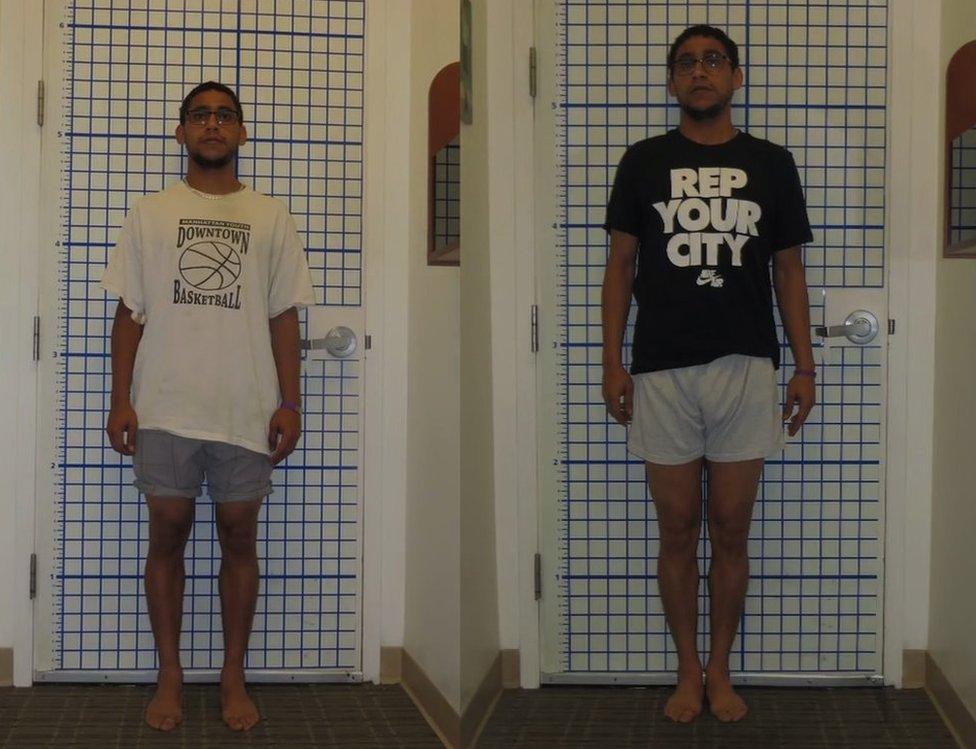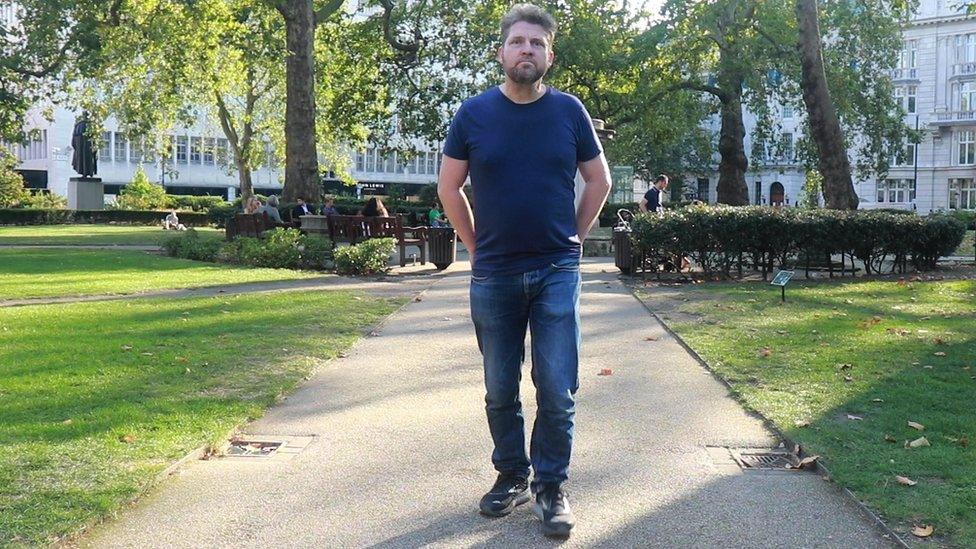Leg-lengthening: The people having surgery to be a bit taller
- Published

Sam underwent surgery in 2015, going from 5ft 4ins (162cm) to 5ft 7ins (170cm)
Each year hundreds of people around the world are opting for long, often painful surgery to extend their legs in a bid to make themselves a few inches taller. But the complex procedure isn't without risk and health experts say some are being left with long-term problems.
Sam Becker was the tallest kid at his middle school, but by the end of high school his peers had left him behind. "When I went to college, I noticed that I was shorter than a lot of the guys and even the girls," he says. "It does affect your life. Honestly, women generally don't date guys that are shorter than them. The hardest thing was sometimes feeling like I won't be able to find a wife."
Sam, now 30, from New York, hoped that he might still grow, though in his heart he knew he had reached his full adult height. "I always thought that being tall and being successful were linked. I had to come up with my own solution."
Will I be able to walk?
Sam researched his options, but was unconvinced by temporary fixes like shoe lifts and stretching exercises. When he came across leg-lengthening, a fascination took root. Following a frank conversation with his mother and weighing up the various risks, he decided the answer to his problems lay on the operating table. He underwent surgery in 2015, going from 5ft 4ins (162cm) to 5ft 7ins (170cm).
"At my first consultation the doctor made it very clear how difficult the surgery was going to be. I was concerned about what I would be able to do after getting those three inches. Will I still be able to walk? Will I still be able to run?
"After I had the operation I was in physical therapy maybe three or four times a week for a few hours each day. I did that for probably six months. It was a very humbling experience. It is kind of crazy… breaking both of your legs and learning to walk again. It's seen as a cosmetic surgery, but I did it a lot more personally for my mental health."

X-rays of Sam's legs before and after (right) the operation show the metal rods he was fitted with
Leg-lengthening surgery is available in more than a dozen countries, with some patients able to increase their height by up to five inches (13cm). And while it's hard to say exactly how many people undergo it each year, clinics say it is gaining in popularity. The BBC has spoken to clinics around the world about the frequency with which they perform the operation and the numbers vary.
At leading centres in the US, Germany and South Korea the procedure is carried out between 100 and 200 times a year. Others - including in Spain, India, Turkey and Italy - perform between 20 and 40 operations a year. In the UK the figure is slightly lower - about 15 times a year. Almost every clinic the BBC spoke to noted an increase year-on-year.
In the UK, it's available at a handful of private clinics regulated by the Care Quality Commission. They charge up to £50,000, while in the US the price ranges from £56,000 up to £210,000 ($75,000 - $280,000).
The surgery is long, expensive and painful. The technique was pioneered by Gavril Ilizarov, a Soviet doctor treating injured soldiers returning from World War Two. And while the surgery has evolved over the last 70 years, many of the principles remain the same.
A hole is drilled into the leg bones - which are then broken in two. A metal rod is surgically fitted inside and held in place by a number of screws. The rod is then slowly lengthened by up to 1mm each day, extending until the patient reaches the desired height and their bones can heal back together.
The patient then requires several months of daily rehabilitation to build up mobility. The process is fraught with the risk of complications, from nerve injuries and blood clots to the possibility of the bones not fusing back together.
I had a three-inch gap
Someone who understands that all too well is Barny. He had the surgery in Italy in 2015, gaining three inches in height - going from 5ft 6in (167cm) to 5ft 9in (175cm). After being diagnosed with a condition that required his legs to be straightened, he opted to have leg lengthening at the same time.
He had been reassured that the procedures could be done together and wouldn't affect his recovery time. But he's been dealing with the consequences ever since. "If I was 16 years old, perhaps it wouldn't have been a problem. But when I had the operation I was 46," he says. "My legs were being pulled apart, but my bones never caught up. I had a three inch gap…just two sticks of bone and a metal bar in between."
Barny recalls the physical discomfort he endured during the lengthening process itself. "It's like every nerve in your legs are being stretched," he says. "There are times when you can't escape anywhere in your head from the pain. It is excruciating."
In spite of the alarming gap between his bones, the weight-bearing rod holding his bones together meant Barny was still able to walk. But the gravity of his situation was clear. "There was a moment of realisation of 'I'm stuck. I'm absolutely stuck'. I was fortunate, my family and employer were amazing. But it can spiral very quickly and you do need a support network. When things go wrong, it goes catastrophically wrong."

Barny: 'I still have a long way to go to recover'
Cosmetic limb-lengthening is limited to private clinics and as such there is little concrete data around the number of patients who go on to experience complications. But Professor Hamish Simpson, of the British Orthopaedic Association, reiterated the potential hazards.
"The techniques and technology have improved substantially over the past couple of decades, making it a safer procedure. However, as well as growing more bone - more muscle, nerve, blood vessels and skin have to be grown and the procedure remains an extremely complex process, with a high complication rate."
Dr David Goodier, a consultant orthopaedic surgeon in the UK, said some of the people he has come across who wanted leg lengthening surgery "have psychological problems", including body dysmorphia. He says as more people opt for the procedure, there is a concern patients will prioritise cost over welfare.
"When faced with the choice of going somewhere with very experienced limb reconstruction surgical expertise versus getting it done on the cheap, I don't think people are necessarily made aware of all the things that can and often do go wrong," he warns. "What happens if you go somewhere, have the surgery done and then return to the UK with complications? The answer is you get sent up to see me on the NHS and we pick up the pieces."
Done and dusted
As for Barny, the day after we met he was having the final metal rod removed from his femur, five years after the original surgery. Despite the pain, the cost and the many years of rehabilitation, he has few regrets. "That will be me, done and dusted," he says.
"Regret is a funny one. There are a lot of people who the surgery has gone right for and you'll never hear from them again… they quietly get on with their lives. I still have a long way to go to recover, but for me the operation was worth it. It has given me the opportunity to recreate my life, free from the prejudice that short people experience."